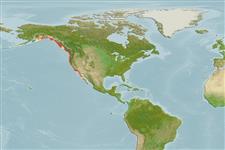Common names from other countries
Classification / Names / Names
Common names | Synonyms | Catalog of Fishes (gen., sp.) | ITIS | CoL | WoRMS
Environment: milieu / climate zone / depth range / distribution range
Ecology
Pelagic; depth range 20 - 180 m (Ref. 275). Tropical, preferred 13°C (Ref. 107945); 62°N - 26°N, 172°W - 112°W (Ref. 112699)
Eastern Pacific. Tropical to boreal.
Length at first maturity / Size / Weight / Age
Maturity: Lm ? range ? - ? cm Max length : 19.2 cm ML male/unsexed; (Ref. 94063); 17.9 cm ML (female); max. published weight: 148.00 g (Ref. 94063); max. published weight: 148.00 g
Caught by brails and night lights and pumps and night lights. Individual behavior: pale coloration indicates relaxation while dark, high contrast chromatic elements indicate alertness; protracted inking occurs after an abrupt stop from a backward jetting squid; in swimming, drag is reduced from the tightening of fin curvature which reduces the fin span relative to the average fin chord; fins and arms were used to maneuver. Schooling and shoaling: schools at night were tighter than during the day (Ref. 94861).
Life cycle and mating behavior
Maturity | Reproduction | Spawning | Eggs | Fecundity | Larvae
Mating and egg-laying occur at daylight (Refs. 94843, 94849), egg beds found at depths of 20-60 m (Ref. 94843).
Roper, C.F.E., M.J. Sweeney and C.E. Nauen. 1984. (Ref. 275)
IUCN Red List Status (Ref. 130435)
CITES status (Ref. 108899)
Not Evaluated
Not Evaluated
Human uses
Fisheries: commercial
FAO - Fisheries: landings | FishSource | Sea Around Us
Tools
Internet sources
Estimates based on models
Preferred temperature
(Ref.
115969): 8.2 - 11.9, mean 9.2 (based on 23 cells).
Resilience
High, minimum population doubling time less than 15 months (K=1).
Prior r = 0.93, 95% CL = 0.61 - 1.39, Based on 2 data-limited stock assessments.
Vulnerability
Low vulnerability (10 of 100).
